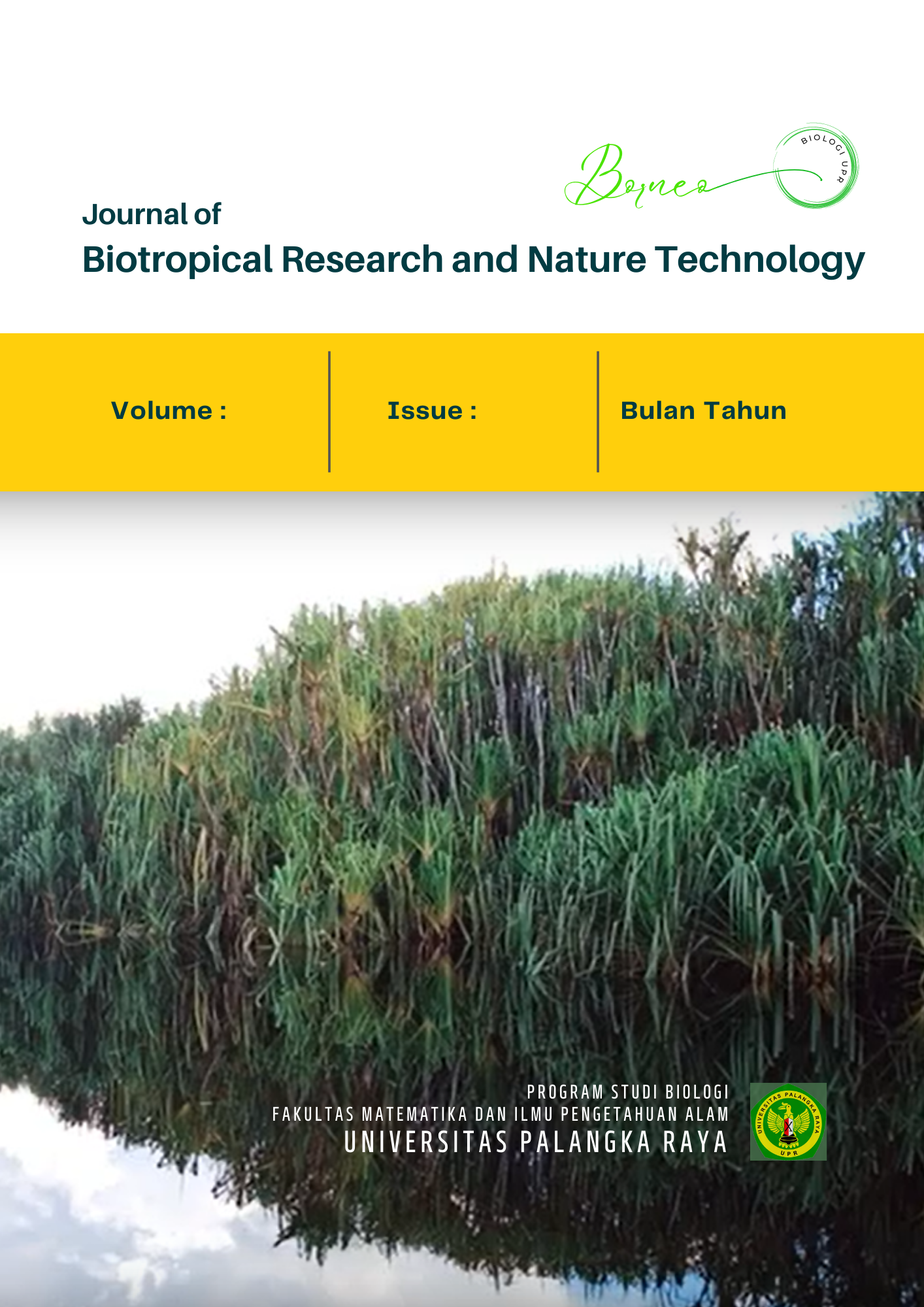Addressing Biodiversity and Sustainability: Challenges and Opportunities in Asia
DOI:
https://doi.org/10.52850/borneo.v3i2.19584Keywords:
Biodiversity; Asia, Climate change; Sustainability; SDGs; AgricultureAbstract
Asia is marked by high biodiversity. At the same time, it suffers from serious multi-factor threats to such biodiversity. Forest ecosystems and their species are threatened due to large-scale land conversion to plantations of agriculture. Land conversion to grasslands due to livestock activities leads to habitat destruction and loss of biodiversity. In addition, global warming is linked to the expansion of pest infestations, resulting in increased application of pesticides that negatively impacts biodiversity. Climate change also facilitates the dissemination of vector-borne disease, further endangering wildlife and human health. Besides, climate change has accelerated biodiversity loss in Asia through alteration of ecosystems, coral bleaching, and melting of Himalayan glaciers threatening freshwater ecosystems. Increased temperature and extreme weather conditions pose a great threat to species survival. Although the Sustainable Development Goals (SDGs) do emphasize the need for biodiversity conservation, this has been outlined in Goal 15, Life on Land, and Goal 14, Life Below Water. In tackling these goals, Asia has a Strategic Plan for Biodiversity 2011-2020 and Global Biodiversity Framework; in core protection ecosystems ensure sustainable development. Much more could be done in reversing, if not definitely halting, this ongoing loss in this region. In conclusion, agriculture, livestock, and climate change pose immense challenges to the biodiversity of Asia, which acts as a barrier to achieving sustainable development goals. Such challenges require enhanced conservation efforts and the adoption of sustainable practices in different sectors.
Downloads
References
T. Nakashizuka, “The role of biodiversity in Asian forests,” J. For. Res., vol. 9, no. 4, pp. 293–298, Nov. 2004, doi: 10.1007/s10310-004-0113-z.
A. C. Hughes, “Understanding the drivers of S outheast A sian biodiversity loss,” Ecosphere, vol. 8, no. 1, p. e01624, Jan. 2017, doi: 10.1002/ecs2.1624.
D. Manjurmahammad, “Wetlands of India with Reference to Ecosystem Wealth, Threats and Management,” Int. J. Zool. Investig., vol. 08, no. 02, pp. 161–170, 2022, doi: 10.33745/ijzi.2022.v08i02.021.
H. Malherbe, S. Pauleit, and C. Lorz, “Mapping the Loss of Ecosystem Services in a Region Under Intensive Land Use Along the Southern Coast of South Africa,” Land, vol. 8, no. 3, p. 51, Mar. 2019, doi: 10.3390/land8030051.
D. Squires, “Biodiversity Conservation in Asia,” SSRN Electron. J., 2013, doi: 10.2139/ssrn.2371165.
M. S. Farhadinia et al., “Current trends suggest most Asian countries are unlikely to meet future biodiversity targets on protected areas,” Commun. Biol., vol. 5, no. 1, pp. 1221–1221, Nov. 2022, doi: 10.1038/s42003-022-04061-w.
H. Boutaj, A. Moumni, O. Nassiri, and A. O. Aitouna, “Climate Change Impacts on Biodiversity in Arid and Semi-Arid Areas,” Res. Anthol. Environ. Soc. Impacts Clim. Change, pp. 578–602, 2022, doi: 10.4018/978-1-6684-3686-8.ch028.
K. C. Seto, M. Fragkias, B. Güneralp, and M. K. Reilly, “A meta-analysis of global urban land expansion,” PloS One, vol. 6, no. 8, pp. e23777–e23777, 2011, doi: 10.1371/journal.pone.0023777.
I. Manisalidis, E. Stavropoulou, A. Stavropoulos, and E. Bezirtzoglou, “Environmental and Health Impacts of Air Pollution: A Review,” Front. Public Health, vol. 8, pp. 14–14, Feb. 2020, doi: 10.3389/fpubh.2020.00014.
J. A. McNEELY, P. Kapoor‐Vijay, L. Zhi, L. Olsvig‐Whittaker, K. M. Sheikh, and A. T. Smith, “Conservation Biology in Asia: the Major Policy Challenges,” Conserv. Biol., vol. 23, no. 4, pp. 805–810, Aug. 2009, doi: 10.1111/j.1523-1739.2009.01284.x.
H. Kioumarsi, K. J. Khorshidi, M. Zahedifar, A. R. Seidavi, S. Z. Mirhossein, and M. R. Taherzadeh, “The Effect of Dietary Energy and Protein Level on Performance, Efficiency and Carcass Characteristics of Taleshi Lambs,” Asian J. Anim. Vet. Adv., vol. 3, no. 5, pp. 307–313, Aug. 2008, doi: 10.3923/ajava.2008.307.313.
A. Mysterud et al., “Monitoring Population Size of Red Deer Cervus Elaphus: An Evaluation of Two Types of Census Data from Norway,” Wildl. Biol., vol. 13, no. 3, pp. 285–298, Sep. 2007, doi: 10.2981/0909-6396(2007)13[285:mpsord]2.0.co;2.
M. Parkes, “Personal Commentaries on ‘Ecosystems and Human Well-being: Health Synthesis—A Report of the Millennium Ecosystem Assessment,’” EcoHealth, vol. 3, no. 3, pp. 136–140, Aug. 2006, doi: 10.1007/s10393-006-0038-4.
S. Younas, D. A. Bukhari, Z. Bibi, A. Ullah, and A. Rehman, “Impact of multistrain probiotics on growth performance, immune response, and gut morphometry in broiler chicken Gallus gallus domesticus,” Poult. Sci., vol. 104, no. 5, p. 105026, May 2025, doi: 10.1016/j.psj.2025.105026.
Y. Wu et al., “Grassland biodiversity response to livestock grazing, productivity, and climate varies across biome components and diversity measurements,” Sci. Total Environ., vol. 878, p. 162994, Jun. 2023, doi: 10.1016/j.scitotenv.2023.162994.
B. Phalan et al., “Crop expansion and conservation priorities in tropical countries,” PloS One, vol. 8, no. 1, pp. e51759–e51759, 2013, doi: 10.1371/journal.pone.0051759.
D. S. Wilcove and L. P. Koh, “Addressing the threats to biodiversity from oil-palm agriculture,” Biodivers. Conserv., vol. 19, no. 4, pp. 999–1007, Jan. 2010, doi: 10.1007/s10531-009-9760-x.
B. Askari, Ghanadamooz. F. M.S, and F. Keshavarzshal A., “Investigating the impact of integrated pest management extension activities in Lahijan and Amlash regions. Agricultural Research,” Agric. Res. Educ. Ext. Organ. Iran, 2016.
F. Boero, “Faculty Opinions recommendation of Bending the curve of terrestrial biodiversity needs an integrated strategy.,” Faculty Opinions – Post-Publication Peer Review of the Biomedical Literature. H1 Connect, Sep. 21, 2020. doi: 10.3410/f.738650542.793578633.
J. Bongaarts, “IPBES, 2019. Summary for policymakers of the global assessment report on biodiversity and ecosystem services of the Intergovernmental Science‐Policy Platform on Biodiversity and Ecosystem Services,” Popul. Dev. Rev., vol. 45, no. 3, pp. 680–681, Sep. 2019, doi: 10.1111/padr.12283.
M. Hrabanski and D. Pesche, “The birth of a science-policy interface for biodiversity: the history of IPBES,” Intergov. Platf. Biodivers. Ecosyst. Serv. IPBES, pp. 53–89, Oct. 2016, doi: 10.4324/9781315651095-13.
S. Hoffmann, “Challenges and opportunities of area-based conservation in reaching biodiversity and sustainability goals,” Biodivers. Conserv., vol. 31, no. 2, pp. 325–352, Feb. 2022, doi: 10.1007/s10531-021-02340-2.
O. Narzullaev, “Sustainable development and biological wealth,” BIO Web Conf., vol. 105, p. 02004, 2024, doi: 10.1051/bioconf/202410502004.
K. S. Bose and R. H. Sarma, “Delineation of the intimate details of the backbone conformation of pyridine nucleotide coenzymes in aqueous solution,” Biochem. Biophys. Res. Commun., vol. 66, no. 4, pp. 1173–1179, Oct. 2016, doi: 10.1016/0006-291x(75)90482-9.
K.-T. Park, J. De Prins, and W. De Prins, “Corrigendum to ‘A checklist of Lecithoceridae (Lepidoptera: Gelechioidea) of the Afrotropical Region’ [Journal of Asia-Pacific Biodiversity 14(2021) 335–370],” J. Asia-Pac. Biodivers., vol. 15, no. 1, p. 146, Mar. 2022, doi: 10.1016/j.japb.2022.01.003.
H. Kioumarsi, Z. S. Yahaya, W. A. Rahman, and P. Chandrawat, “A New Strategy that Can Improve Commercial Productivity of Raising Boer Goats in Malaysia,” Asian J. Anim. Vet. Adv., vol. 6, no. 5, pp. 476–481, Apr. 2011, doi: 10.3923/ajava.2011.476.481.
T. D. Ramsfield, B. J. Bentz, M. Faccoli, H. Jactel, and E. G. Brockerhoff, “Forest health in a changing world: effects of globalization and climate change on forest insect and pathogen impacts,” Forestry, vol. 89, no. 3, pp. 245–252, Mar. 2016, doi: 10.1093/forestry/cpw018.
W. Anderson and T. Johnson, “Evaluating Global Land Degradation Using Ground-Based Measurements and Remote Sensing,” Econ. Land Degrad. Improv. – Glob. Assess. Sustain. Dev., pp. 85–116, Nov. 2015, doi: 10.1007/978-3-319-19168-3_5.
S. Muchuru and G. Nhamo, “A review of climate change adaptation measures in the African crop sector,” Clim. Dev., vol. 11, no. 10, pp. 873–885, Mar. 2019, doi: 10.1080/17565529.2019.1585319.
S. M. Mahdavian, F. Askari, H. Kioumarsi, R. Naseri Harsini, H. Dehghanzadeh, and B. Saboori, “Modeling the linkage between climate change, CH4 emissions, and land use with Iran’s livestock production: A food security perspective,” Nat. Resour. Forum, Jun. 2024, doi: 10.1111/1477-8947.12532.
S. Kumar, “Agricultural Productivity, Food Security and Climate Change: A State-Level Analysis,” State Indian Agric. Agric. Product. Food Secur. Clim. Change, pp. 222–237, 2020, doi: 10.4135/9789353885953.n11.
L. Kalavari, N. Nasiri, F. Ahmadian, and H. Kioumarsi, “Enrichment of Doogh with Olive Leaf Extract and Investigation of Its Physicochemical, Microbial, and Sensory Properties during Storage at Room Temperature and Refrigerator,” J. Multidiscip. Appl. Nat. Sci., vol. 3, no. 1, pp. 34–42, Aug. 2022, doi: 10.47352/jmans.2774-3047.143.
M. H. Egerer, S. M. Philpott, H. Liere, S. Jha, P. Bichier, and B. B. Lin, “People or place? Neighborhood opportunity influences community garden soil properties and soil-based ecosystem services,” Int. J. Biodivers. Sci. Ecosyst. Serv. Manag., vol. 14, no. 1, pp. 32–44, Dec. 2017, doi: 10.1080/21513732.2017.1412355.
H. Kioumarsi et al., “Estimation of Relationships Between Components of Carcass Quality and Quantity in Taleshi Lambs,” Asian J. Anim. Vet. Adv., vol. 3, no. 5, pp. 337–343, Aug. 2008, doi: 10.3923/ajava.2008.337.343.
Y. Wang and K. Wesche, “Vegetation and soil responses to livestock grazing in Central Asian grasslands: a review of Chinese literature,” Biodivers. Conserv., vol. 25, no. 12, pp. 2401–2420, Jan. 2016, doi: 10.1007/s10531-015-1034-1.
N. Kumar and J. George, “Harnessing the Potential of Regional Value Chains for Sustainable Development in Southern Asia: Towards a South Asia Comprehensive Economic Partnership (SACEP),” South Asia Econ. Policy Stud., pp. 45–63, 2020, doi: 10.1007/978-981-15-3932-9_4.
H. Ming et al., “Tailored poly-heptazine units in carbon nitride for activating peroxymonosulfate to degrade organic contaminants with visible light,” Appl. Catal. B Environ., vol. 311, p. 121341, Aug. 2022, doi: 10.1016/j.apcatb.2022.121341.
A. Khakpour, N. A. Shadmehri, H. Amrulloh, and H. Kioumarsi, “Antibacterial Effect of Juglans regia, Citrus sinensis, Vicia faba, and Urtica urens Extracts under In vitro Conditions,” Bioactivities, vol. 1, no. 2, pp. 74–80, Oct. 2023, doi: 10.47352/bioactivities.2963-654x.195.
M. Crippa, E. Solazzo, D. Guizzardi, F. Monforti-Ferrario, F. N. Tubiello, and A. Leip, “Food systems are responsible for a third of global anthropogenic GHG emissions,” Nat. Food, vol. 2, no. 3, pp. 198–209, Mar. 2021, doi: 10.1038/s43016-021-00225-9.
M. Springmann et al., “Options for keeping the food system within environmental limits,” Nature, vol. 562, no. 7728, pp. 519–525, Oct. 2018, doi: 10.1038/s41586-018-0594-0.
N. Kabisch et al., “Nature-based solutions to climate change mitigation and adaptation in urban areas: perspectives on indicators, knowledge gaps, barriers, and opportunities for action,” Ecol. Soc., vol. 21, no. 2, 2016, doi: 10.5751/es-08373-210239.
N. Seddon, B. Turner, P. Berry, A. Chausson, and C. A. J. Girardin, “Grounding nature-based climate solutions in sound biodiversity science,” Nat. Clim. Change, vol. 9, no. 2, pp. 84–87, Jan. 2019, doi: 10.1038/s41558-019-0405-0.
R. Kemp and D. Loorbach, “Transition Management: A Reflexive Governance Approach,” Reflexive Gov. Sustain. Dev., Mar. 2006, doi: 10.4337/9781847200266.00015.
Downloads
Published
How to Cite
Issue
Section
License
Copyright (c) 2025 Bahareh Rafiei, Hamed Kioumarsi, Hanif Amrulloh, Hadis Ahmadnia, Marzieh Alidoust Pahmedani, Zeynab Kazemkhah Hasankiadeh

This work is licensed under a Creative Commons Attribution-ShareAlike 4.0 International License.
- Authors retain copyright and acknowledge that the Journal of Multidisciplinary Applied Natural Science is the first publisher, licensed under a Creative Commons Attribution-Share Alike 4.0 (CC BY-SA).
- Authors are able to enter into separate, additional contractual arrangements for the non-exclusive distribution of the journal's published version of the work (e.g., post it to an institutional repository or publish it in a book), with an acknowledgment of its initial publication in this journal.
- Authors are permitted and encouraged to post their work online (e.g., in institutional repositories or on their website) prior to and during the submission process, as it can lead to productive exchanges and earlier and greater citation of published work.








